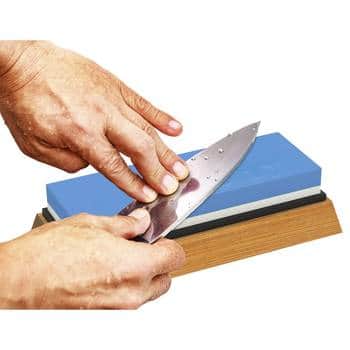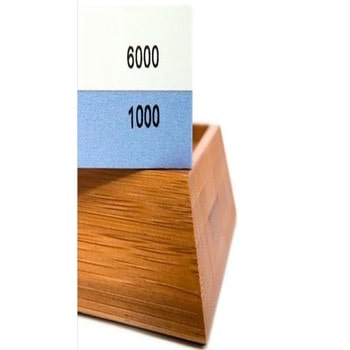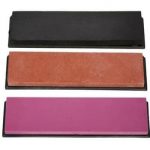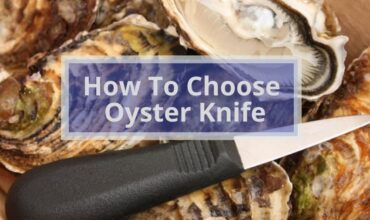The most important tool in your kitchen is definitely the chef’s knife. So what happens when that lifesaving tool starts to get dull and give you smashed bread and squished tomatoes? You will use the honing rod you got with the knife set, right? Wrong answer!!
A honing steel only straightens the edge of your knife and doesn’t sharpen it! So it’s time to learn how to use a whetstone to sharpen a knife!
Whetstones are the most traditional and popular way to sharpen knives. So if you prefer whetstones over electric and manual sharpeners, then this handy step-by-step guide is just for you.
First of all, Choosing Your Whetstone
If you don’t have a whetstone and want to buy one. There are few things you need to take into consideration.
As a beginner, you should look for a double-sided stone. One side should be 6000 grit, and the other side should be 1000 grit. Keep in mind that the lower the number is, the coarser the stone gets.
When you increase the grit, you will get a sharper knife blade. however, it requires extra strokes.
We recommend buying a complete set with different sizes and tools. You can take a look at our list of the best whetstone sharpening set.
How to sharpen a kitchen knife with a whetstone?

The required tools
- The knife
- Whetstone
- water
- Towel
Gather your tool because we are going to revive your knives back
Read also , Things to Consider When Buying an Electric Knife Sharpener
Step 1: Wet the Stone
Most whetstones need to be soaked in water before using. We recommend soaking 45 at least, or till there are no air bubbles on the water surface. and then put them on a dry towel.
If you own a stone fixer, then you should put it in water as well.
Step 2: Adjust the Angle
This step is considered to be the most difficult one. Yesm it is difficult, but not impossible!
There are just a few things you should know before setting the angle. First, smaller angles will result in having sharper edges. however, these edges will not be so much durable.
While bigger angles will do the exact opposite. giving a less sharp blade yet a durable one.
Second, the easiest way to sharpen a knife is to place it in a position between vertical and horizontal, which is from 15 to 20 degrees angle.
Finally, you should maintain the angle throughout the process to end with a good sharp shape. Any change in the angle could be dangerous and may result in damaging the knife blade.
Step 3: Sharpen the knife
It is preferable to start with the lower grit first. after adjusting the angle, start to sharpen in a back and forth motion.
The pressure comes on the back motion while dragging the knife. It’s better to start with the side that is closest to the handle and end with the edge point.
Step 4: Finsih a Stroke and Repeat
Every time you reach the end point of the edge, this counts as one stroke. You need to repeat the strokes till you feel that the knife blade is sharp enough.
Step 5: Look for Silty Water
After multiple strokes, you will see silt water over both the stone and the knife. This liquid means that you are one the right track.
Step 6: Check the Burrs
Seeing burrs is a sign for you to head to the other side. It should take from 30 to 40 strokes per side to get these burrs.
If you don’t want to over sharpen your blades. then 10-15 strokes will be enough.
Also read , How to Hone Your Knife?
Step 7: Sharpen the Other Side
Wet your stone and knife with drops of water, maintain the same angle and repeat.
Remember to end the stroke with the tip of the knife over the near-edge of the stone.
Step 8: Switch the Stone
If you have a complete set or a double-sided whetstone, it’s time to use the finer-grit one, whether it is separated or in the same whetstone.
Step 9: Repair the whetstones
After many strokes, you will see grooves in the stone. So it’s always recommended to buy a stone fixer. All you have to do is to put the stone fixer against the whetstone stone, then push it back and forth.
This motion will result in creating a new flat surface thanks to the grinding part.
Having grooves on the stone will hinder the process and delay the effectiveness.
Step 10: Clean up
Place the stone and knife over a towel to dry thoroughly. And keep in mind that the grit doesn’t come out with the towel. So, try to make a special one for this purpose.
Step 11: Hone your Blades
The final step in sharpen a knife is to hone your knife using a honing steel to have an alignment shape.
you can test the sharpness of your knives by cutting a hard tomato or chopping onions.
Also check, What are the Benefits of Oysters?
What grit whetstone for kitchen knives should you use?

Before talking about the right grit to use, you should know about the range of their sizes.
- The first range is less than 1000 grit, which is mostly used in repairing the chipped edges of knives.
- The second range is from 1000 to 3000 grit, it is mainly used for sharpening dull knives and other steel tools.
- The last range of 4000 to 8000 grit are called the finishing stones. They are made to refine and leave a mirror polish over the knife sharp edge.
Before using any size of the pre-mentioned grits, you should identify the type of your blade firstly. For example, you shouldn’t apply more than 6000 grit on meat knives to prevent any bending in them.
- In case you have some chips over the knife-edge that you want to grind them off, you should go for the whetstones that range from 120 up to 400.
- If you are looking for a standard sharpening, then go for stones that range from 700 and 2000 grit.
- As a final touch, for removing burrs and fine scratches that are resulted from coarser stones. you need whetstones that starts from 2000 grit and higher.
- If you are a beginner, you can stick with the 3000 up to 6000 grit.
- if you are expert enough to master the finish, then definitely go with the finished stone with a size of 8000 grit.
Check also, Best Bread Knife Review
Where to buy whetstone?
If you have King of Knives in your country, you can buy the wet stone from there. You can also find them at Chef’s Armoury. If you don’t have these stores around you, you may also find them in local hardware stores.
You can also look at stone’s home center, where you can find a bunch of tools that will help you in sharpening.
Knife sharpener vs. whetstone
Should you buy an electric knife sharpener that will get the job done quickly without the fear of the wrong angle or should you buy a sharpening stone?
Well, when it comes to the sharpening quality, the whetstone is 100% a winner. But when it comes to saving time and effort, the electric sharpener or even a manual sharpener are the winners.
So you should get the sharpening tool that’s suitable for you and will meet your needs.
Read more , How to shuck oysters without an oyster knife
Should I keep a Whetstone Grit Guide?
If you have a memory of a goldfish, then you should definitely keep a chart with you.
You can print a one and keep so that you can look at before every use. Try to print a one that is not complicated yet contain all the information you will need. Look for a one that includes the material of your knives.
Are colors a determining factor in a whetstone?

If you look at any whetstone, you may find that they may differ in colors. You will find many colors like red, brown, and others. Actually colors aren’t a measuring factor.
You can find the same color in different grade and different classification. The texture is the defining factor in these stones.
What is the ultimate goal of using whetstones?
Ideally, we use sharpening stones, whetstones, water stones, and others to create a razor-sharp layer for our pocket knife, hunting knife, paring knife, scissors, Japanese knife and more.
Read more , How to Care for Your Paring Knife?
Tips for maintaining a sharp knife
All the following steps will support maintaining your knives for a long time.
- Always cut your foods over a cutting board.
- Try to hand-wash them instead of throwing them in the dishwasher.
- Do not leave your knives in the sink for a long time; soaked knives don’t last.
- Remember to sharpen your knife from time to time gently.
- Do not cut meat on a ceramic plate.
Now you must’ve known how to use a whetstone to sharpen a Knife, haven’t you?





